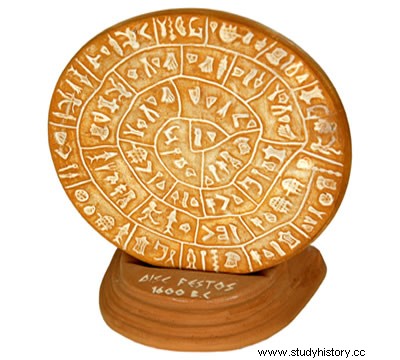
By Tales Pinto
Among the great mysteries that intrigue archaeologists – and they are not few – is the Phaisto disk (or Phaisto disk, or Phaisto disk). The disc is a ceramic piece, made of fine clay, found in the palace of Faisto, on the island of Crete, and produced by the Creto-Minoan civilization, between the years 1900 BC. and 1450 BC. What mainly intrigues historians and archaeologists are the signs printed on both sides of the disk and what meaning they would have.
Due to the very fact that it was possibly printed with stamps that reproduced the symbols, the disc could indicate the oldest known typographic object. However, there is no certainty about the meaning of each of the symbols. Cretan writing was lost after the invasion of the region by the Dorians, around the 11th century BC.
The disc was found by a team of archaeologists led by Luigi Pernier in 1908 in the south-central region of the island of Crete. Archaeologists were excavating the ruins of the ancient palace, possibly destroyed by earthquakes, when they found the disc measuring 16 centimeters in diameter by 16 millimeters thick. Among the signs present on the disc are representations of humans, animals, plants and everyday objects. These signs form 31 groups of signs on side A and 30 groups on side B, containing 241 printed symbols.
What scholars seek is to try to relate the origin of the people who inhabited the island during the Minoan period and from there to relate it to writings of other peoples who possibly had contact with the Cretans, like the Semites and the Egyptians. The icons could be ideograms, like those used by the Egyptians, which would make it possible to try to match the disc reading. Vertical lines that separate and group some of the icons, along the spiral arrangement of the images, suggest that these groups would be words or phrases with specific meanings.
In this sense, several attempts at deciphering were made. Some point to the disk as an ancient calendar. Other scholars say that the discus is a rudimentary game used by the Cretans for their leisure.
There is even a possibility that the record is a sacred hymn, composed in honor of the mother goddess. There are strong indications that the Cretans were socially organized in matriarchies, which guaranteed women an unsubjugated position in society, as was the case in patriarchal societies at the time. This role of women is even indicated as a result of the fact that the Cretans were dedicated to trade and navigation, with women playing a role as social organizers of the cities.
Finally, it should be noted that there are even hypotheses that decipher the disk as a historical representation of part of the Cretan civilization, indicating the taking of geographically close locations and foreign invasions.
But the most important thing is to realize how much we still don't know about humanity's past. It remains for us to accept our ignorance and continue our research to try to fill in the gaps in our historical knowledge.
